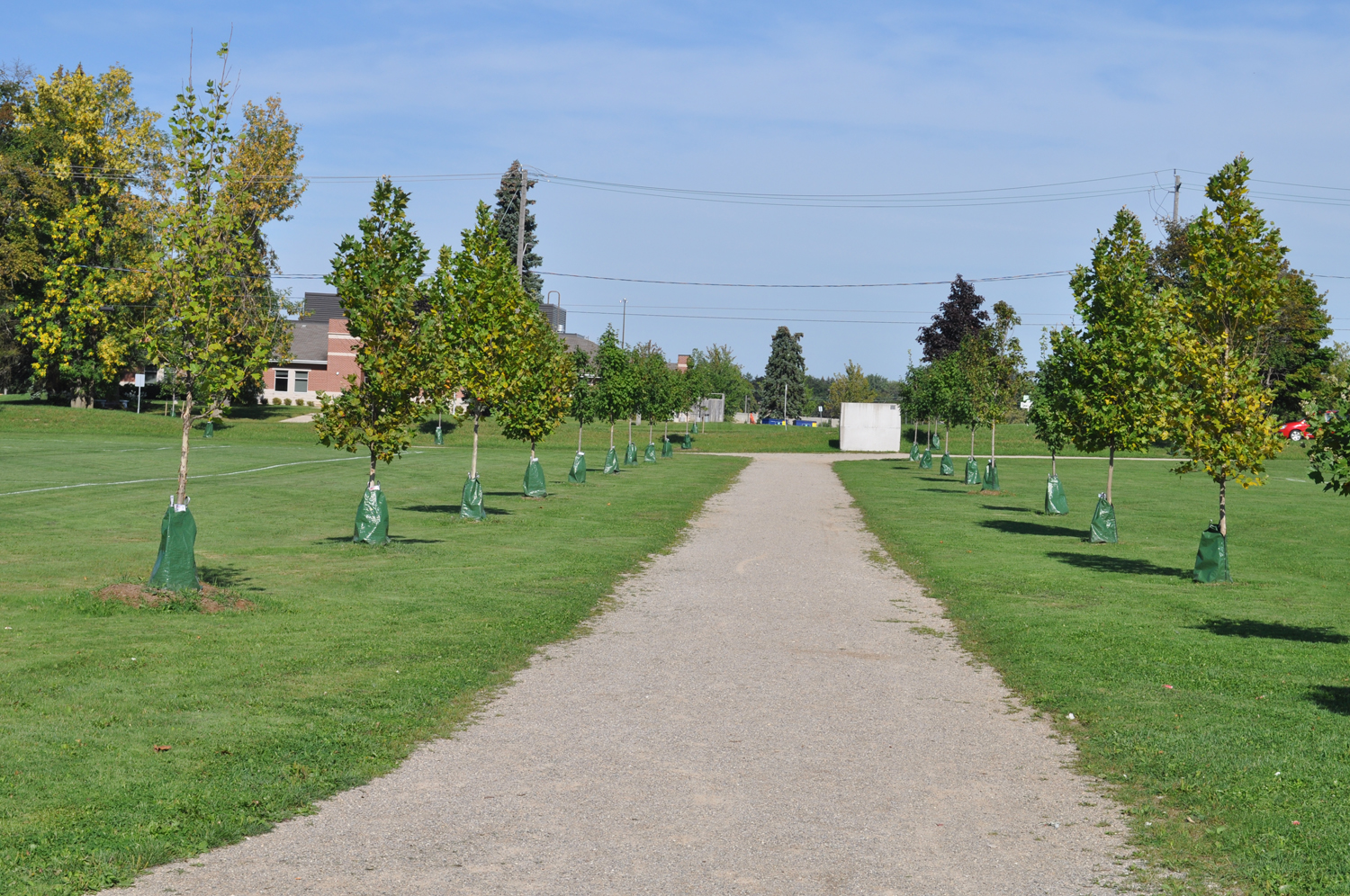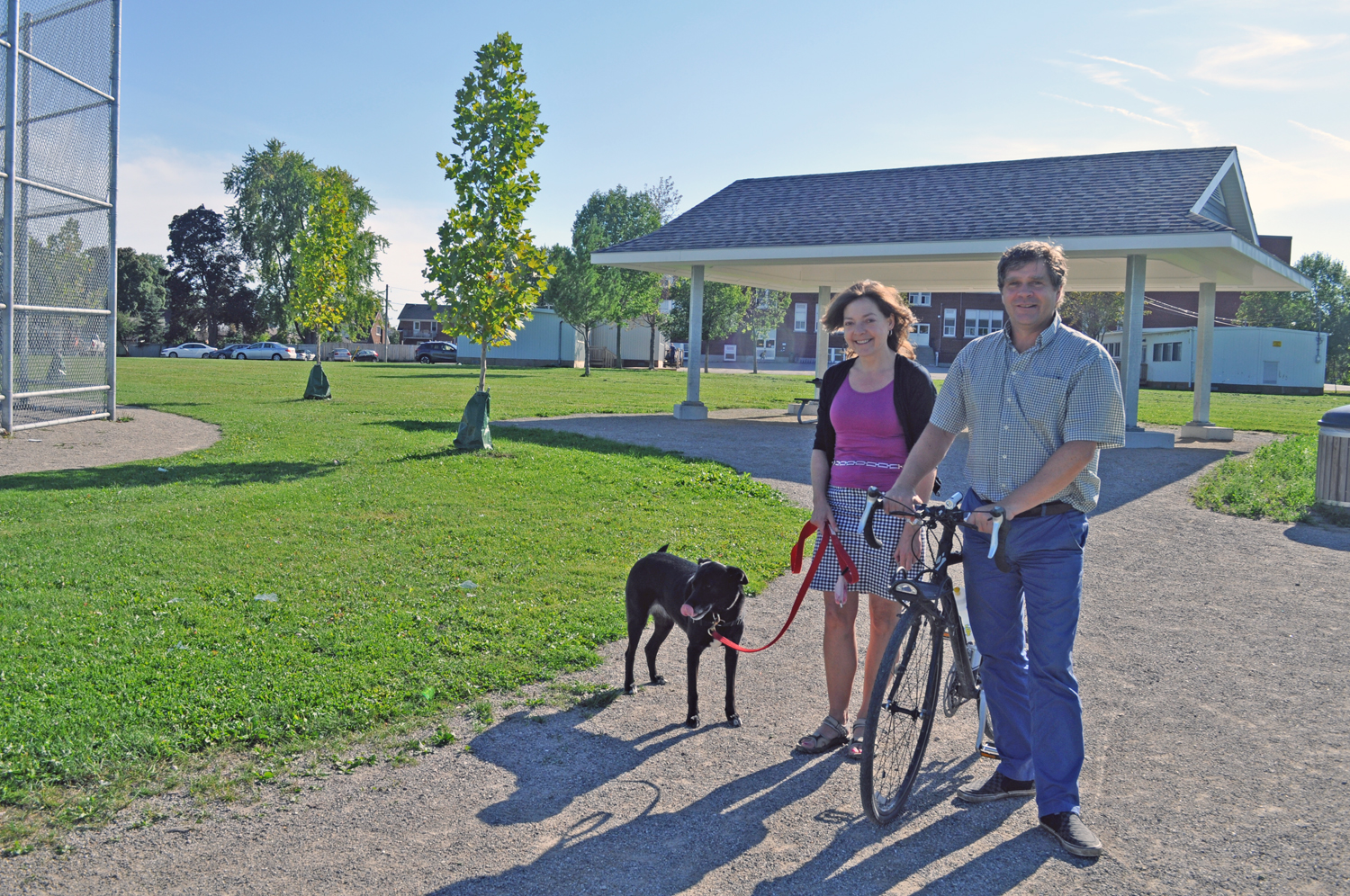

FORMER ARMY TRAINING BASE
Knollwood Park renovations turn underused
field into downtown neighbourhood treasure
Knollwood Park renovations turn underused
field into downtown neighbourhood treasure
For News Tips & Advertising call...
Kitchener East - 519-578-8228
Kitchener West - 519-394-0335
By Carrie Debrone
Kitchener Citizen
September 17, 2015
It used to be green space that few people used – in fact, neighbours used to walk around it to avoid going through Knollwood Park in Kitchener because it was often quite wet.
Not any more.
Knollwood Park has blossomed into a well-used community space that is attractive and welcoming, thanks to the efforts of the City of Kitchener and the residents of the Auditorium Neighbourhood Association (ANA).
The upgrade is part of a City of Kitchener program to look at all downtown area parks and invest in them.
Located behind Sheppard Public School and across from the Kitchener Auditorium, the park, which dates back to 1931, has been completely transformed.
On September 20 neighbours and officials will gather to officially open the upgraded site with a ribbon-cutting and plaque dedication.
The park’s $100,000 reconstruction began in 2013 and was completed in two phases over the last few years.
Jean Markovich, ANA vice-president, walks through the park almost daily with her dog, Lily.
“Before it was just a field and it was often wet so I used to walk around it. A neighbour who comes here in the morning told me she sees a lot of joggers now,” Markovich said.
“I think many people appreciate the new trees in the park,” said ANA president Brian Laube, who has lived in the area since 2001.
“They are noticing if they are low on water and keeping a watch on them,” Laube said.
“People are now treating the park as though it is their own,” said Markovich.
Walkways lined with 49 trees now wind invitingly through the 8.3-acre park and attach themselves to its bordering sidewalks on Borden, East and Stirling Avenues. The trees include 25 Sugar Maples and 16 London Plane, as well as several Cucumber and Autumn Blaze trees.
Earth removed to sculpt the trails was used to create a berm along the park’s East Ave boundary that serves to define the space, but also provides a barrier to wayward soccer balls and a buffer from road traffic.
Another change was the repositioning and renovation of the park’s large baseball diamond. The diamond was turned 180 degrees to face the park’s northeast corner, so batters now hit into the treed hilly area of the park rather than into adjacent walking trails and the soccer field. Both the ball diamond and the soccer field, which is home to the association’s Hood Kids soccer program, are owned by the city and available for sports groups to rent.
“The outfield used to overlap with the soccer field so that was completely redesigned,” said Mark Paris, City of Kitchener Landscape Architect, who was responsible for the renovations.
An old hydro sub station that stood at the corner of Stirling and East Ave was in poor condition and was removed.
New climbing equipment was also installed at the playground located along the Borden Ave. side of the park.
In the middle of the park stands its most recent, and most prominent, addition -- a new pavilion sheltering several picnic tables. It was paid for with generous donations from the park’s neighbours, including a $25,000 donation from the Kitchener Rangers based at the Kitchener Auditorium across the street.
The neighbourhood association also used the $10,000 grant it won at the 2013 Kitchener Festival of Neighbourhoods to help fund the pavilion project.
“The idea for the pavilion really got started by our past president Markus Philipp,” said Laube, who explained the association believed it would provide a needed central gathering point as well as a place to sit.
Laube said the association “is also greatly indebted to” architect and local longtime resident David Thompson.
“He really put in a lot of hours to help design the pavilion,” he said.
The residents have also raised funds for a new community bulletin board sign that will be installed at the corner of Stirling and East Ave. The sign will be used to post notices and information about community and neighbourhood events.
“I think it’s a fabulous park. Its functionality is greatly improved, especially with the new pavilion. That’s a tremendous achievement for the community. The park has never been used more,” Paris said.
Knollwood Park was not always a park. During the Second World War, the site was part of a training camp for the Canadian Women’s Army Corps (CWAC).
Originally opened as No. 10 Non-permanent Active Militia Training Centre for men in 1940, the camp was transferred to the Canadian Women’s Army Corps in 1942 for their use for the remainder of the war.
Many of the 17,000 Canadian women who served in the Canadian Women’s Army Corps took their training at the Knollwood Armories.
When the camp closed in October 1946, it was the last of the CWAC training camps in Canada to close. The former camp was then used as a vocation training centre for returning servicemen, and briefly as a training camp for the 48th Field Squadron of the Royal Canadian Engineers.
During post-war reconstruction, the twin cities faced an acute housing shortage and the City of Kitchener converted the Knollwood army base buildings into temporary apartments.
The 40 buildings on the site were gradually taken down over the years. Only two remain today.
Located at 350 East Ave. across the street from the park, they are used by the 1596 Royal Highland Fusiliers of Canada Royal Canadian Army Cadet Corps.
Local residents continue to raise funds for future park upgrades they would like to make, including cladding the pavilion pillars with brick, placing benches on the hill and extending the trails.
Kitchener Citizen
September 17, 2015
It used to be green space that few people used – in fact, neighbours used to walk around it to avoid going through Knollwood Park in Kitchener because it was often quite wet.
Not any more.
Knollwood Park has blossomed into a well-used community space that is attractive and welcoming, thanks to the efforts of the City of Kitchener and the residents of the Auditorium Neighbourhood Association (ANA).
The upgrade is part of a City of Kitchener program to look at all downtown area parks and invest in them.
Located behind Sheppard Public School and across from the Kitchener Auditorium, the park, which dates back to 1931, has been completely transformed.
On September 20 neighbours and officials will gather to officially open the upgraded site with a ribbon-cutting and plaque dedication.
The park’s $100,000 reconstruction began in 2013 and was completed in two phases over the last few years.
Jean Markovich, ANA vice-president, walks through the park almost daily with her dog, Lily.
“Before it was just a field and it was often wet so I used to walk around it. A neighbour who comes here in the morning told me she sees a lot of joggers now,” Markovich said.
“I think many people appreciate the new trees in the park,” said ANA president Brian Laube, who has lived in the area since 2001.
“They are noticing if they are low on water and keeping a watch on them,” Laube said.
“People are now treating the park as though it is their own,” said Markovich.
Walkways lined with 49 trees now wind invitingly through the 8.3-acre park and attach themselves to its bordering sidewalks on Borden, East and Stirling Avenues. The trees include 25 Sugar Maples and 16 London Plane, as well as several Cucumber and Autumn Blaze trees.
Earth removed to sculpt the trails was used to create a berm along the park’s East Ave boundary that serves to define the space, but also provides a barrier to wayward soccer balls and a buffer from road traffic.
Another change was the repositioning and renovation of the park’s large baseball diamond. The diamond was turned 180 degrees to face the park’s northeast corner, so batters now hit into the treed hilly area of the park rather than into adjacent walking trails and the soccer field. Both the ball diamond and the soccer field, which is home to the association’s Hood Kids soccer program, are owned by the city and available for sports groups to rent.
“The outfield used to overlap with the soccer field so that was completely redesigned,” said Mark Paris, City of Kitchener Landscape Architect, who was responsible for the renovations.
An old hydro sub station that stood at the corner of Stirling and East Ave was in poor condition and was removed.
New climbing equipment was also installed at the playground located along the Borden Ave. side of the park.
In the middle of the park stands its most recent, and most prominent, addition -- a new pavilion sheltering several picnic tables. It was paid for with generous donations from the park’s neighbours, including a $25,000 donation from the Kitchener Rangers based at the Kitchener Auditorium across the street.
The neighbourhood association also used the $10,000 grant it won at the 2013 Kitchener Festival of Neighbourhoods to help fund the pavilion project.
“The idea for the pavilion really got started by our past president Markus Philipp,” said Laube, who explained the association believed it would provide a needed central gathering point as well as a place to sit.
Laube said the association “is also greatly indebted to” architect and local longtime resident David Thompson.
“He really put in a lot of hours to help design the pavilion,” he said.
The residents have also raised funds for a new community bulletin board sign that will be installed at the corner of Stirling and East Ave. The sign will be used to post notices and information about community and neighbourhood events.
“I think it’s a fabulous park. Its functionality is greatly improved, especially with the new pavilion. That’s a tremendous achievement for the community. The park has never been used more,” Paris said.
Knollwood Park was not always a park. During the Second World War, the site was part of a training camp for the Canadian Women’s Army Corps (CWAC).
Originally opened as No. 10 Non-permanent Active Militia Training Centre for men in 1940, the camp was transferred to the Canadian Women’s Army Corps in 1942 for their use for the remainder of the war.
Many of the 17,000 Canadian women who served in the Canadian Women’s Army Corps took their training at the Knollwood Armories.
When the camp closed in October 1946, it was the last of the CWAC training camps in Canada to close. The former camp was then used as a vocation training centre for returning servicemen, and briefly as a training camp for the 48th Field Squadron of the Royal Canadian Engineers.
During post-war reconstruction, the twin cities faced an acute housing shortage and the City of Kitchener converted the Knollwood army base buildings into temporary apartments.
The 40 buildings on the site were gradually taken down over the years. Only two remain today.
Located at 350 East Ave. across the street from the park, they are used by the 1596 Royal Highland Fusiliers of Canada Royal Canadian Army Cadet Corps.
Local residents continue to raise funds for future park upgrades they would like to make, including cladding the pavilion pillars with brick, placing benches on the hill and extending the trails.
Kitchener Auditorium Neighbourhood Association President Brian Laube (right) and Vice-president Jean Markovich and her dog Lily walk through the reconstructed Knollwood Park, located across the street from the Kitchener Auditorium. The new pavilion in the background was paid for with funds raised by local neighbours, a $25,000 grant from the Kitchener Rangers, and the $10,000 capital grant the association won at the 2013 Festival of Neighbourhoods. The pavilion provides an attractive and prominent central gathering point for the well-used park.


New paths lined with 49 trees wind their way through Knollwood Park.